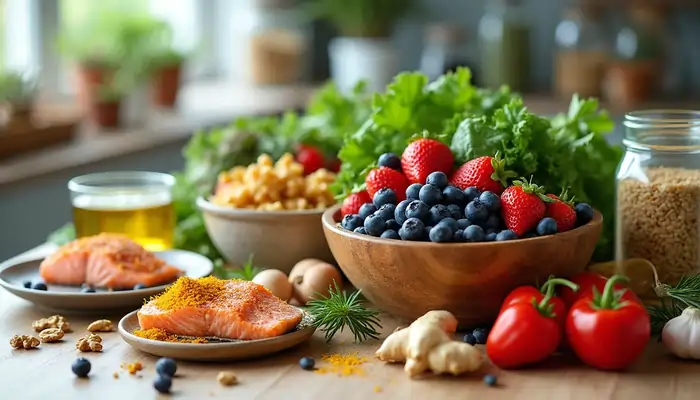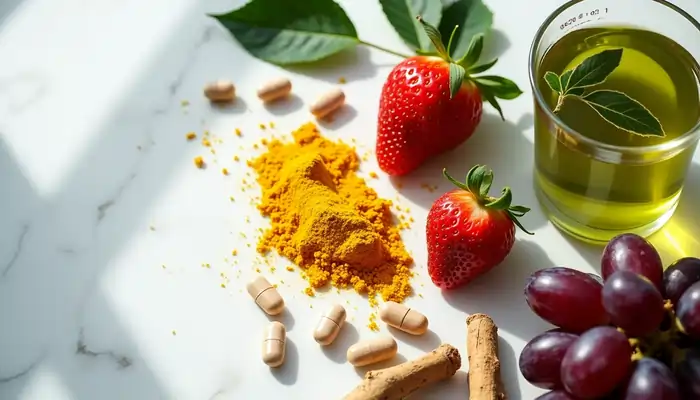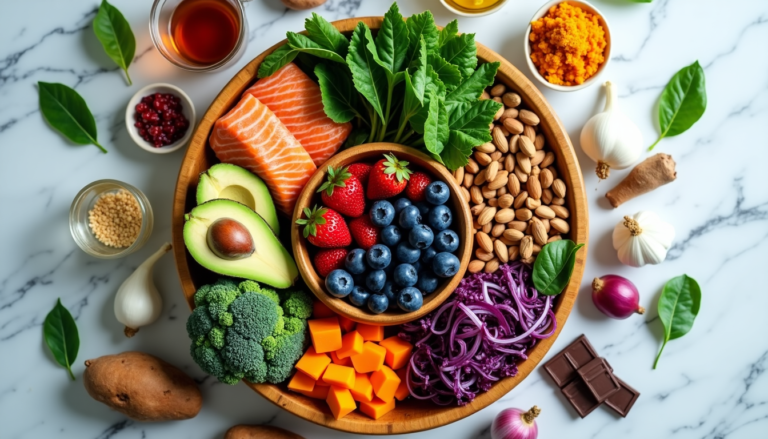Healthy Diet for Longevity: Science-Backed Foods & Eating Patterns (2025)

A healthy diet for longevity goes beyond the latest superfood trend. Science-backed nutrition can extend your life. Research proves that specific nutrients can change the aging process at a cellular level. Leafy greens alone link to a remarkable 25% lower risk of death from any cause.
People in the world’s “blue zones” live past 100 regularly. Their diets focus on whole, natural foods. These longevity herbs and superfoods work together to promote healthy aging and longer life. The role of superfoods becomes vital for seniors as they age, since all but one of these adults face Vitamin B12 deficiency by age 38. Simple dietary changes can make a big difference. A small handful of nuts each day links to a 20% better chance of living longer. Eating fatty fish once or twice weekly helps maintain verbal memory.
In this piece, we’ll look at what science really tells us about living longer through our food choices. You’ll get practical advice to create your own healthy diet for longevity, drink and superfood diet plan, without any hype.
The Link Between Diet and Longevity
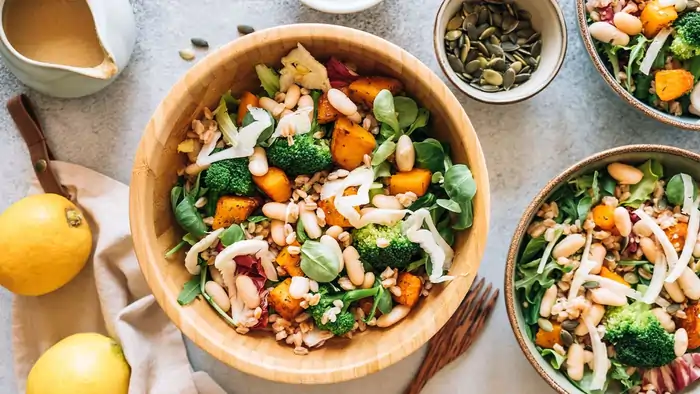
Image Source: Everyday Health
“Let food be your medicine and medicine be your food.”
— Hippocrates, Ancient Greek physician, considered the father of modern medicine
Your body ages at a microscopic level each day. The food you eat directly affects how fast your cells break down or how well they work. New research shows that your food choices can change the biological processes that determine how long you’ll live, and they might add healthy years to your life [1].
How food affects aging at the cellular level
Cells show aging through several key mechanisms. Telomere length serves as one vital marker—these protective DNA-protein structures sit at chromosome ends and naturally get shorter each time cells divide [2]. Studies reveal that women who eat plenty of fruits, vegetables, and whole grains—while avoiding added sugar and processed meats—have longer telomeres than those with poor eating habits [2].
Cellular senescence is a state where cells stop growing and cause inflammation. These senescent cells build up as we age and reduce how well our tissues work [2]. Your food choices can speed up or slow down this buildup.
Your genes also control aging. A newer study, published in 2011 by researchers using the GrimAGE2 clock (an algorithm that measures methylation patterns) found each extra gram of daily sugar aged people by 7 days [3]. But diets rich in antioxidants and anti-inflammatory nutrients showed good results by reducing biological age [3].
Research shows that eating too many calories speeds up cellular aging, especially in fat tissue. Reducing calories without causing malnutrition remains the best non-genetic way to slow aging by decreasing senescent cells [2].
The role of oxidative stress and inflammation
Oxidative stress happens when your body has too many free radicals (unstable molecules) and not enough antioxidants. The National Institutes of Health defines it as “a condition that may occur when there are too many unstable molecules called free radicals in the body and not enough antioxidants to get rid of them” [1]. This imbalance hurts cells, proteins, DNA, and speeds up aging.
Free radicals, including reactive oxygen species (ROS) and reactive nitrogen species (RNS), start chain reactions that affect many cell functions [1]. These molecules damage cell walls, DNA, enzymes, and other cell parts, which speeds up aging [1].
Scientists have linked oxidative stress to “all but one of these chronic diseases” [1]. Research connects it to heart disease, type 2 diabetes, brain disorders, and various cancers [4].
Chronic inflammation—often called “inflammaging”—is a vital factor in faster aging. This mild but constant inflammatory state shows increased levels of proteins like IL-6, IL-1, and TNF-α [5]. While inflammation helps protect us, long-term inflammation leads to age-related diseases [4].
How diet influences these processes:
Different eating patterns either increase or curb oxidative stress and inflammation:
- Sugar-heavy diets create more advanced glycation end products (AGEs), which cause inflammation and speed up aging [3][4]
- High-fat foods can trigger inflammatory responses in fat tissue [4][4]
- Refined carbs with high glycemic index cause quick blood sugar spikes, creating free radicals [1]
- Plant foods rich in antioxidants neutralize free radicals directly [1]
Your daily food choices create either a pro-aging or anti-aging environment in your body. Mediterranean and other anti-inflammatory diets reduce inflammatory markers like C-reactive protein and TNF-α better than typical Western diets [4][4].
Scientists keep finding stronger evidence about diet’s effect on longevity. Healthy diet for longevity isn’t just about eating superfoods—it creates an environment that protects cells, reduces inflammation, and helps repair mechanisms work better [2].
Specific nutrients show promising anti-aging benefits: sulforaphanes from cruciferous vegetables turn on protective enzymes; vitamin C protects cells from inflammatory damage; vitamin E shields DNA; and polyphenols boost gut immunity while fighting inflammation [1]. These elements are the foundations of an effective healthy diet for longevity that extends healthy life.
Resources from authority sites:
- National Institute on Aging: https://www.nia.nih.gov/health/what-do-we-know-about-healthy-aging
- Harvard Nutrition Source: https://www.hsph.harvard.edu/nutritionsource/anti-inflammatory-diet/
- Mayo Clinic: https://www.mayoclinic.org/healthy-lifestyle/nutrition-and-healthy-eating/
What We Can Learn from the Blue Zones

Image Source: Inc. Magazine
Around the world, regions known as “Blue Zones” give us amazing insights into healthy diet for longevity that help people live longer. These five places—Okinawa (Japan), Sardinia (Italy), Nicoya (Costa Rica), Ikaria (Greece), and Loma Linda (California)—have more people living past 100 than anywhere else [6]. Their healthy diet for longevity and telomere-supporting foods teach us valuable lessons about living longer.
Common dietary patterns in long-living populations
The people in Blue Zones eat remarkably similar foods, even though they live in different cultures. Research analyzing 154 dietary surveys from all five Blue Zones shows about 95% of centenarians ate mostly plant-based foods with beans as their life-blood [7]. These long-lived people eat meat much of either—roughly five times monthly, if they eat it at all [6].
The way they eat shows careful portion control. Okinawans live by a Confucian saying to eat until they’re 80% full [7]. These centenarians eat their biggest meal at breakfast, a medium-sized lunch, and their smallest dinner. They practiced time-restricted eating long before it became popular [7][3].
People in Blue Zones share these approaches to preparing and finding food:
- They eat mostly whole, single-ingredient foods [3]
- About 90% of their food comes from within a 10-mile radius of their homes [3]
- Many grow vegetables, which gives them daily exercise and sun exposure for vitamin D [1]
- Traditional cooking methods make their food taste great [1]
A WHO-funded study of five countries revealed eating just 20 grams of beans daily lowered someone’s yearly death risk by 8% [1][3]. Middle-aged people who ate a cup of cooked greens daily were twice as likely to survive the next four years compared to those who ate none [3].
Plant-based focus and minimal processed foods
Legumes, vegetables, fruits, whole grains, and nuts are the foundations of Blue Zones eating. Studies consistently show these plant-based diets (PBDs) lead to lower death rates than diets that keep taking them meat [1][1].
Research confirms PBDs relate to fewer diseases and better long-term health [1]. These benefits happen through several ways:
- Better metabolic and inflammatory markers [1][1]
- Fewer heart problems [1][1]
- Healthier gut bacteria [1][1]
- Benefits from eating less protein and certain amino acids [1][1]
Dr. Loy, who studies Blue Zones, points out: “Beans and legumes—almost every diet has them in some form or another. One study found that legumes are the most important dietary predictor of survival in older people of different ethnicities” [6].
People in Blue Zones consume about 28 grams (7 teaspoons) of added sugar daily [1][8]—just one-fifth of what average Americans eat [3]. They save sweet treats for special occasions and stay away from processed foods [1][3].
Blue Zones residents avoid:
- Processed foods and salty snacks [4][3]
- Processed meats and meat products [4][3]
- Large amounts of red meat [4][3]
- Refined grains and oils [4][3]
- Sugary foods and drinks [4][3]
Research suggests that healthy diet for longevity helps people live longer through protein restriction and limiting certain amino acids [1]. Notwithstanding that, people over 65 might need more protein [1], which means diet adjustments become necessary with age.
Exploring these longevity hotspots reveals practical ways to live better—eat whole plant foods, limit processed items, control portions, and create food environments that support healthy diet for longevity without feeling deprived.
Resources from authority sites:
- Blue Zones: https://www.bluezones.com/recipes/food-guidelines/
- National Institute on Aging: https://www.nia.nih.gov/health/healthy-eating
- World Health Organization: https://www.who.int/news-room/fact-sheets/detail/healthy-diet
Top 8 Superfoods That Support a Longer Life
Adding specific nutrient-rich foods to your meals can change how long you live and your quality of life. Scientists have found certain superfoods that directly affect how we age. Let’s take a closer look at eight amazing food groups that could be a part of healthy diet for longevity and perhaps can help you live longer.
1. Leafy greens and cruciferous vegetables
Broccoli, cabbage, and kale are nature’s longevity medicine. People who eat cruciferous vegetables five or more times weekly have a 35% lower risk of heart disease [5]. These vegetables pack special sulfur compounds called glucosinolates that help prevent cancer and reduce inflammation [9]. They’re rich in fiber, which helps maintain healthy weight and gut function—both vital for living longer [9]. Just four to five servings weekly can lower your risk of cancer and other chronic diseases [9].
2. Berries and their antioxidant power
Berries pack antioxidants that help curb cell damage. Blueberries have 40 times more antioxidants than many common fruits and vegetables [10]. People who eat berries regularly have a 25% lower risk of early death compared to those who don’t [11]. Their anthocyanins (compounds that give berries their bright colors) target inflammation. Research links blueberries to better heart health, easier weight control, and brain protection [12].
3. Nuts and seeds for heart and brain health
Eating a handful of nuts daily could help you live longer. Research following nearly 120,000 people found that daily nut-eaters were 20% less likely to die during the 30-year study [2]. Nuts help lower bad cholesterol while raising good cholesterol and improving blood pressure responses to stress [2]. People who eat nuts often maintain better weight control, thanks to their protein and fiber content that keeps you feeling full [2]. Harvard’s research shows nuts can “protect your heart, fight cancer, reduce inflammation, and act as antioxidants” [2].
4. Beans and legumes for fiber and protein
Beans are the life-blood of longevity diets worldwide. Studies show that every 20 grams of legumes you eat might add about eight years to your life [13]. People who eat beans four times weekly have a 22% lower risk of heart disease [13]. Beans cost less than meat (one cent per gram of protein versus four cents for beef) and offer great nutrition [14]. Their special fiber helps control blood sugar and feeds good gut bacteria [14].
5. Fatty fish and omega-3s
People with high omega-3 levels from fish tend to live longer. A study of over 117,000 people found those with the highest DHA levels had a 21% lower risk of death from any cause [15]. You need about 1,000 milligrams of DHA+EPA daily to keep your omega-3 levels optimal [15]. Japanese people, who eat more oily fish than most nations, live about five years longer than Americans [6].
6. Fermented foods for gut health
Fermented foods improve gut health and reduce inflammation markers. Stanford scientists found that eating fermented foods for just 10 weeks led to better microbial diversity and lower inflammation in the blood [7]. Foods like yogurt, kimchi, and kombucha help digestion and might boost immune function and longevity [16]. Look for “naturally fermented” on labels to get the most benefits [17].
7. Turmeric and other longevity herbs
Turmeric’s curcumin has shown amazing anti-aging effects. Lab studies found curcumin increased lifespan by 26% [18]. It helps fight inflammation, reduces oxidative stress, and affects proteins that control aging like sirtuins and AMPK [19]. Mix turmeric with black pepper or healthy fats to help your body absorb it better [20].
8. Green tea and matcha as longevity drinks
Adding three cups of tea daily might lower your risk of early death by 24%—that’s like adding two years to your life [21]. Matcha (powdered green tea) packs more benefits—it has 137 times more EGCG than regular green tea [22]. Middle-aged and older adults who had two grams of matcha daily for 12 weeks showed better brain function than those who didn’t [21].
Resources from authority sites:
- National Institute on Aging: https://www.nia.nih.gov/health/healthy-eating
- Harvard Nutrition Source: https://www.hsph.harvard.edu/nutritionsource/
- American Heart Association: https://www.heart.org/en/healthy-living/healthy-eating
How Superfoods Work Together in a Balanced Diet
Superfoods become more powerful when they work together. A healthy diet for longevity doesn’t just rely on individual “miracle foods.” The best results come from nutrients that complement each other. Scientists call this “food synergy” – different foods working together to give you better health benefits than eating them separately [1].
Superfoods Working Together
Foods boost each other’s benefits when their nutrients interact effectively [23]. To cite an instance, see how vitamin C makes your body absorb plant-based iron up to six times better [24]. That’s why eating iron-rich spinach with citrus fruits packs such a powerful nutritional punch.
Here are some powerful combinations:
Turmeric and black pepper: Black pepper’s piperine helps your body absorb curcumin from turmeric 2000% better [23]. This combination maximizes turmeric’s anti-inflammatory benefits, which makes it great for longevity.
Tomatoes and olive oil: Your body absorbs lycopene better when you cook tomatoes with olive oil. This helps prevent cell damage that leads to cancer [25]. The healthy fats help this nutrient get into your bloodstream.
Green tea and lemon: Adding citrus juice helps you absorb EGCG (green tea’s main antioxidant) ten times better than drinking plain green tea [8]. The catechins and vitamin C work together perfectly.
Studies show whole foods give you better benefits than isolated nutrients [1]. Research in the Journal of Agricultural and Food Chemistry found that adding garlic and onion to grains helps you absorb more iron and zinc [26]. Smart food combinations are essential to healthy diet for longevity which support healthy aging and living longer.
Smart Ways to Combine Nutrients
More superfoods don’t always mean better health. What matters is nutrient density – the amount of nutrients per calorie [27]. Scientists warn against thinking one superfood can do it all, since no single food gives you complete nutrition [4].
Your plate should work like a nutrient portfolio. Research confirms that foods work better together than alone [1]. Eating different colored foods gives you a complete range of nutrients that support a longer, healthier life.
Nutrition experts say, “But rather than focus on one specific superfood, try to eat a full rainbow of foods” [28]. This approach gives you various plant compounds that work together for better cell health.
Rush University found eating just one serving of leafy greens daily keeps your brain as sharp as someone 11 years younger [14]. These vegetables need healthy fats to work properly. Pairing them with good fats helps your body use all their nutrients.
Older adults need certain combinations even more. Vitamin D works with calcium for stronger bones [25], while fermented foods and fiber create a healthier gut [8]. Learning these relationships helps you get the most from your superfoods diet.
Some nutrients affect how well others work. Copper-zinc and manganese-iron compete with each other [1]. Taking too much of one mineral might block another from working properly. Balance matters more than quantity.
Resources from authority sites:
- National Institute on Aging: https://www.nia.nih.gov/health/healthy-eating
- Harvard Nutrition Source: https://www.hsph.harvard.edu/nutritionsource/
- American Heart Association: https://www.heart.org/en/healthy-living/healthy-eating
The Truth About Superfood Powders and Supplements
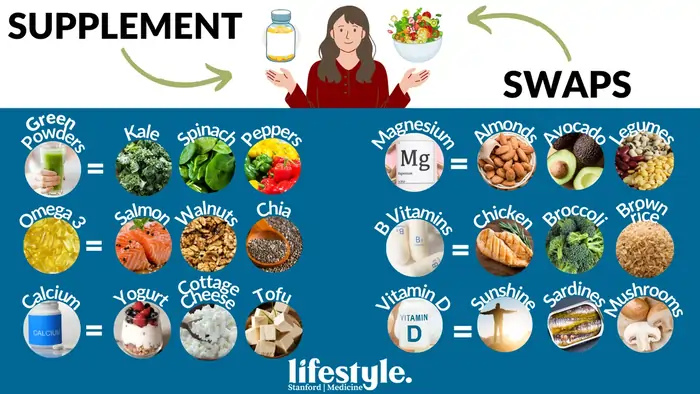
Image Source: Stanford Center on Longevity
The supplement industry has boomed over the last several years. Superfood powders claim to pack the nutritional magic of whole foods into convenient scoops. About 82% of people take at least one supplement daily. Vitamin sales jumped 51% in early 2020 compared to 2019 [29]. But behind these marketing claims lies a deeper truth about these concentrated nutrient sources.
Do they work as well as whole foods?
The simple answer is no. Stanford nutrition experts strongly recommend getting nutrition from food instead of supplements where possible [3]. The biological reality is stark: fruits and vegetables lose their original structure when processed into powder form. This makes their nutrient availability questionable [3]. One researcher puts it plainly: “You can’t supplement your way out of a poor diet” [3].
Whole foods offer a complex mix of nutrients that work better together [30]. These nutrients cooperate more effectively in their natural state than when isolated in supplements [30]. Of course, one big drawback of powders is the loss of fiber. While whole foods give you substantial fiber that helps digestion and heart health, a typical greens powder has just two grams of fiber. This pales in comparison to the 15 grams you get from five daily servings of whole fruits and vegetables [31].
Supplement regulation raises serious concerns. The FDA technically “regulates” dietary supplements, but companies don’t need clinical research, approval, or notification to sell them [29]. These products also aren’t affordable – green powders cost around $40 for 30 servings ($1.33 each), while frozen vegetables cost about 25 cents per serving [31].
When powders might be helpful
Despite their limits, superfood powders can play specific roles in a healthy diet for longevity. High-quality supplements become valuable in certain situations:
- Blood tests show specific nutrient deficiencies [3]
- If you have special dietary restrictions or absorption issues [32]
- During immune challenges or tissue repair periods [32]
- Parents with picky children who need more nutrients [5]
The right approach treats supplements as their name suggests – extras to support a healthy whole-foods diet [29]. Some research shows potential benefits. Powdered greens might reduce oxidative stress or help lower blood pressure [9].
Quality matters if you choose to use supplements. Look for products tested by third-party organizations like ConsumerLab, US Pharmacopeia, or NSF International [3]. This verification will give accurate ingredients [9]. The FDA also warns against mixing supplements or taking too many because this can be dangerous [33].
Fruits and vegetables should be the foundations of your healthy diet for longevity. Supplements should only play a supporting role [9]. Nutrition experts say it best: “Think of powdered greens as a bonus” [9].
Resources from authority sites:
- U.S. Food and Drug Administration: https://www.fda.gov/food/dietary-supplements
- National Institutes of Health: https://ods.od.nih.gov
- Harvard School of Public Health: https://www.hsph.harvard.edu/nutritionsource/
Diet Strategies Backed by Science
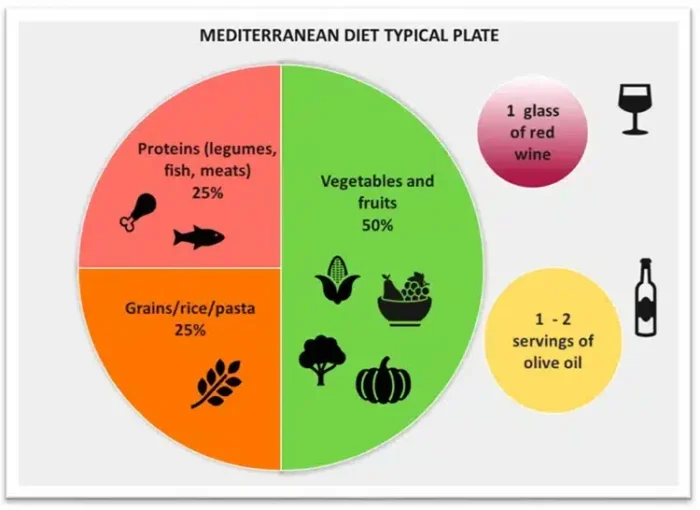
Image Source: PCOS Diet Support
“The food you eat can be either the safest and most powerful form of medicine or the slowest form of poison.”
— Ann Wigmore, Holistic health practitioner and nutritionist
Science has discovered that specific dietary patterns and eating strategies can extend lifespan. These methods work by affecting your body’s basic aging processes through detailed nutritional systems rather than single nutrients.
Intermittent fasting and time-restricted eating
Time-restricted eating (TRE) only allows food consumption during specific windows, usually 8-12 hours each day. Studies show this method supports your body’s natural circadian rhythms and makes metabolic health better [34]. It improves cellular resilience by triggering autophagy—when cells recycle damaged components [10]. The process also lowers inflammation and oxidative stress without reducing total caloric intake [11].
You can practice intermittent fasting in several ways:
- Alternate-day fasting (ADF): Switch between normal eating days and severe restriction
- 5:2 approach: Eat normally five days a week with two days of reduced calories
- Time-restricted feeding (TRF): Eat only during 6-12 hour windows daily
A mouse study revealed that intermittent fasting increased median lifespan without much reduction in total calories [12]. Human studies showed that even an 11% calorie reduction, instead of the planned 25%, made cardio-metabolic health better and might slow aging [34].
Intermittent Fasting Protocols
Rather than constant restriction, intermittent fasting alternates between periods of normal eating and fasting:
- Time-Restricted Eating (16:8):
- Protocol: 16-hour daily fast with 8-hour eating window
- Research Results: 3-5% weight loss and improved insulin sensitivity in 12 weeks
- Practicality: High adherence rates (>80%) in clinical studies
- 5:2 Diet:
- Protocol: 5 days normal eating, 2 non-consecutive days of 500-600 calories
- Research Results: Similar weight loss to continuous caloric restriction but better adherence
- Health Markers: Reduced inflammatory markers and improved insulin sensitivity
- Alternate-Day Fasting:
- Protocol: Alternating between normal eating days and fasting/very low calorie days
- Research Results: Most effective for quick weight loss but lower adherence
- Longevity Effects: Strongest autophagy activation—cellular “cleanup” associated with longevity
Who Should Avoid Fasting
Fasting protocols are not suitable for everyone:
- Pregnant or breastfeeding women
- People with history of eating disorders
- Those with diabetes (especially on medication) without medical supervision
- Children and adolescents
Mediterranean and DASH diets
The Mediterranean diet stands as the “gold standard in preventive medicine” because it combines anti-inflammatory elements perfectly [35]. People who keep taking these foods have a 9-52% lower risk of cardiovascular disease and live 7-47% longer [35].
This diet focuses on:
- Plant foods in abundance (vegetables, fruits, nuts, legumes)
- Fish and seafood in moderate amounts
- Red meat and processed foods in small quantities
- Olive oil as the main fat source
The DASH (Dietary Approaches to Stop Hypertension) diet offers similar health benefits. A newer study, published in [36] by researchers who tracked 120,000 people for three decades, found these healthy eating patterns cut early death risk by 20%. Both diets tap into the potential of whole, minimally processed foods [37].
Caloric restriction and longevity
Caloric restriction (CR)—eating 20-40% fewer calories without malnutrition—remains the most effective way to extend lifespan across species [12]. Mice that ate 40% fewer calories lived 36.3% longer than those that ate freely [12].
The first human randomized controlled trial of CR showed it slowed biological aging by 2-3%, which could mean a 10-15% lower mortality risk [34]. While strict 25-40% restrictions challenge most people, even small reductions in calories show positive effects [34].
Caloric restriction—reducing daily calories by 20-40% without malnutrition—is the most consistently validated intervention for extending lifespan across species:
- Animal Research: Studies show mice living up to 36.3% longer with 40% caloric reduction
- Human Studies: The CALERIE trial demonstrated 2-3% slower biological aging with just 12% caloric reduction
- Cellular Mechanisms: Activates sirtuins and AMPK pathways while reducing mTOR signaling, mimicking similar pathways as exercise
Resources from authority sites:
- National Institute on Aging: https://www.nia.nih.gov/health/calorie-restriction-and-fasting-diets-what-do-we-know
- Harvard Nutrition: https://www.hsph.harvard.edu/nutritionsource/healthy-weight/diet-reviews/
- American Heart Association: https://www.heart.org/en/healthy-living/healthy-eating
When it comes to fasting for longevity, consistency matters more than intensity. Even a 12-hour overnight fast can trigger beneficial autophagy processes without requiring extreme restriction.” — Dr. Rhonda Patrick, Ph.D in biomedical science and expert in nutritional health
Comparing the Most Effective Dietary Patterns for Longevity
Recent scientific research has identified several dietary patterns consistently associated with longer lifespan and healthier aging. Let’s examine the evidence for each:
Mediterranean Diet
- Key Components: Olive oil, fish, nuts, whole grains, fruits, vegetables, moderate wine
- Research Evidence: Associated with 20% reduced all-cause mortality and 26% lower cardiovascular risk in multiple studies
- Longevity Mechanism: Reduces inflammation (shown by 24% lower CRP levels) and improves lipid profiles
DASH Diet (Dietary Approaches to Stop Hypertension)
- Key Components: Low sodium, rich in fruits, vegetables, whole grains, lean proteins
- Research Evidence: 18% reduced risk of heart disease and stroke
- Longevity Mechanism: Blood pressure reduction (average 11 mmHg systolic in clinical trials)
MIND Diet (Mediterranean-DASH Intervention for Neurodegenerative Delay)
- Key Components: Leafy greens, berries, nuts, olive oil, whole grains, fish, poultry
- Research Evidence: 53% lower risk of Alzheimer’s when strictly followed; 15% lower all-cause mortality
- Longevity Mechanism: Protects against cognitive decline and neuroinflammation
Plant-Based Diet
- Key Components: Whole, minimally processed plant foods — vegetables, legumes, fruits, whole grains, nuts, seeds
- Research Evidence: Associated with 25% reduction in all-cause mortality and 28% lower risk of heart disease
- Longevity Mechanism: Lowers cholesterol, improves gut microbiota, reduces IGF-1 and inflammation
Blue Zones Diet
- Key Components: 90–95% plant-based; beans, greens, sweet potatoes, whole grains, minimal meat, moderate alcohol
- Research Evidence: Common among longest-lived populations (e.g., Okinawa, Sardinia, Nicoya)
- Longevity Mechanism: Low calorie density, high fiber, low animal protein, strong cultural habits and lifestyle integration
Comparative Effectiveness
| Dietary Pattern | All-Cause Mortality Reduction | Heart Disease Risk Reduction | Cancer Risk Reduction |
|---|---|---|---|
| Mediterranean | 20% | 26% | 13% |
| DASH | 18% | 21% | 8% |
| MIND | 15% | 19% | 7% |
| Plant-based | 25% | 28% | 14% |
How Dietary Needs Change With Age: Decade-by-Decade Guide
Our nutritional needs evolve as we age. Here’s how to optimize your diet for longevity at every stage:
In Your 40s: Metabolism Support
- Key Nutritional Focus: Preventing metabolic slowdown and preserving muscle mass
- Recommended Daily Intake:
- Protein: 1.0-1.2g per kg body weight (higher end if active)
- Fiber: 25-30g to combat slowing digestion
- B Vitamins: Increased B12 and folate as absorption begins declining
- Foods to Emphasize: Lean proteins, cruciferous vegetables, berries, green tea
- Why It Matters: Studies show metabolic rate declines approximately 2-3% per decade after 40
In Your 50s: Cardiovascular Protection
- Key Nutritional Focus: Heart health and bone density preservation
- Recommended Daily Intake:
- Omega-3s: 1,000-1,500mg daily
- Calcium: 1,200mg for women, 1,000mg for men
- Magnesium: 320mg for women, 420mg for men
- Foods to Emphasize: Fatty fish, nuts, seeds, leafy greens, fermented foods
- Why It Matters: Heart disease risk increases significantly after 50, with women’s risk accelerating post-menopause
Ultra-Processed Foods: The Hidden Threat to Longevity
What Are Ultra-Processed Foods?
Ultra-processed foods (UPFs) are industrial formulations containing ingredients rarely used in home kitchens, including:
- High-fructose corn syrup
- Hydrogenated oils
- Hydrolyzed proteins
- Numerous additives like emulsifiers, colorants, and flavor enhancers
Research on UPFs and Healthy Aging
Recent research published in Nature Medicine found alarming connections:
- 32% lower odds of healthy aging with each 10% increase in dietary UPF content
- Negative associations with all components of healthy aging, including:
- Cognitive function
- Cardiovascular health
- Metabolic health
- Immune function
- Physical function
How UPFs Accelerate Aging
UPFs influence aging through multiple pathways:
- Disrupting gut microbiome: Leading to increased inflammation
- Introducing advanced glycation end products (AGEs): Promoting cellular aging
- Displacing nutrient-dense foods: Creating micronutrient deficiencies
- Altering brain reward pathways: Promoting overconsumption
Common UPFs to Avoid
| Category | Examples | Healthier Alternatives |
|---|---|---|
| Beverages | Sodas, sweetened coffee drinks | Herbal tea, infused water |
| Snacks | Chips, packaged cookies | Nuts, fresh fruit, vegetable sticks |
| Breakfast | Sugary cereals, toaster pastries | Oatmeal with berries, eggs with vegetables |
| Convenience meals | Frozen dinners, instant noodles | Batch-cooked soups, grain bowls |
Putting It All Together: Longevity Diet Meal Planning
2-Day Longevity Meal Plan Example
This simple meal plan incorporates the principles discussed throughout this article:
Monday
- Breakfast: Mediterranean Veggie Omelet (2 eggs with spinach, tomatoes, olives)
- Lunch: Quinoa bowl with chickpeas, cucumber, cherry tomatoes, and olive oil dressing
- Dinner: Baked salmon with roasted Brussels sprouts and sweet potato
- Snack: Handful of walnuts and blueberries
Tuesday
- Breakfast: Overnight oats with chia seeds, cinnamon, and mixed berries
- Lunch: Mediterranean tuna salad with white beans, arugula, and olive oil
- Dinner: Lentil soup with dark leafy greens and whole grain bread
- Snack: Apple slices with almond butter
Quick Longevity-Boosting Recipes
Turmeric-Ginger Anti-Inflammatory Smoothie
This nutrient-dense smoothie combines multiple longevity-promoting ingredients.
Ingredients:
- 1 cup unsweetened plant milk
- 1/2 cup frozen berries
- 1 tablespoon ground flaxseed
- 1/2 teaspoon turmeric
- Small piece fresh ginger
- 1 teaspoon honey (optional)
- Pinch of black pepper (enhances turmeric absorption)
Instructions:
- Combine all ingredients in a blender
- Blend until smooth
- Serve immediately
“The dietary patterns consistently associated with longevity aren’t about deprivation—they’re about abundance of the right foods. The longest-lived populations consume 20-30 different plant foods weekly, creating a diverse microbiome that impacts everything from immunity to cognitive health.” — Dr. Valter Longo, Director of the Longevity Institute at USC
Common Myths About Longevity Diets
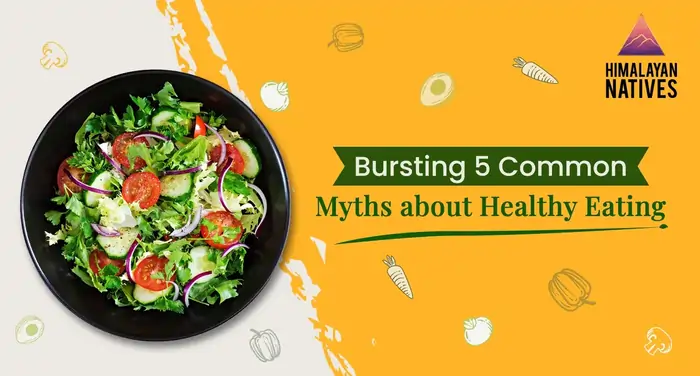
Image Source: Himalayan Natives
Nutrition myths about longevity and healthy diet for longevity often cloud scientific facts, which leads people to waste money on ineffective solutions. These false beliefs drain resources and potentially harm health goals.
Debunking the ‘one superfood fixes all’ myth
Nutrition experts strongly emphasize that “no magic ingredient or superfood exists” [2]. The biggest myth in healthy diet for longevity suggests that one food—kale, açai berries, or turmeric—can extend life alone. Science proves that all but one of these foods lack the complete nutrients needed for optimal health [38].
“People are fascinated by the promise of a silver bullet to affect health and cure all sorts of infirmities,” says Dr. Luigi Fontana [2]. This fascination pushes many people toward exotic or trendy foods, seeking benefits that science hasn’t proven.
Research shows that proven longevity herbs and superfoods work differently in isolation. Compounds like resveratrol or quercetin rarely match the benefits they provide in natural food combinations [2]. The nutrient interactions in whole foods create effects that supplements cannot duplicate.
Why variety matters more than hype
Dietary diversity stands as the life-blood of healthy diet for longevity among nutrition scientists. People with higher dietary diversity scores show better cognitive function, fewer physical limitations, and reduced psychological stress [39].
A significant study revealed that increased diet diversity reduced all-cause mortality in Chinese and Japanese populations [39]. The largest longitudinal study on dietary diversity found that “reaching and maintaining a higher DDS (Dietary Diversity Score) was associated with a decreased risk of all-cause mortality” [40].
Harvard’s Frank Hu explains that healthy eating doesn’t require strict rules [37]. Combining elements from proven dietary patterns—Mediterranean or Okinawan—enhances enjoyment and helps people stick to their diets longer [37].
The best strategy for healthy diet for longevity includes eating “different foods in the right amount to balance out the consumption of calories and protein with our energy expenditure while providing all the essential nutrients, fibers, and phytochemicals” [2].
Resources from authority sites:
- Harvard T.H. Chan School of Public Health: https://www.hsph.harvard.edu/nutritionsource/
- National Institute on Aging: https://www.nia.nih.gov/health/healthy-eating
- American Heart Association: https://www.heart.org/en/healthy-living/healthy-eating
How to Start a Longevity-Focused Eating Plan
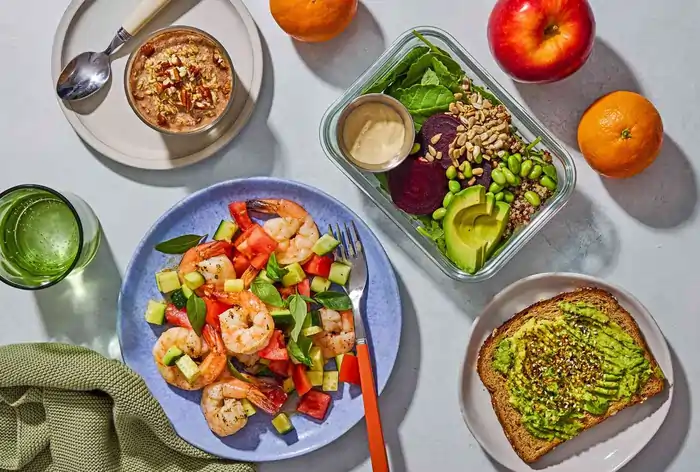
Image Source: EatingWell
A healthy diet for longevity doesn’t need an overnight transformation of your diet. You can start with small, manageable changes that gradually improve your eating habits. Research shows even modest dietary adjustments bring notable health benefits. Simple food substitutions can reduce mortality risk by up to 17% [13].
Simple swaps to make today
Food exchanges offer an easy way to start your health experience. Plant-based oils like olive, soybean, or canola can replace butter to lower premature death risk [13]. Fatty fish instead of red meat provides heart-healthy omega-3 fatty acids. People who eat salmon show 16-22% lower cardiovascular disease risk compared to rare consumers [14].
Other evidence-backed substitutions include:
- White to whole: Choose whole grains over refined versions. Studies link whole grain consumption to decreased heart disease and diabetes risk [4].
- Soda to tea: Green and black tea contain flavan-3-ols that support heart health. Just 2 cups daily provides the recommended 400-600 milligrams [41].
- Processed meat to plant protein: Research shows the best longevity gains come from reducing processed meat consumption [14].
These changes don’t need to happen immediately. The transition becomes easier when you start with foods you already enjoy [42].
Building meals around superfoods
Vegetables should form the base of longevity-promoting meals. Nutritionists suggest creating a “rainbow plate” with colorful plants [4]. Your daily goal should include two cups of fruit and three cups of vegetables (a cup equals roughly tennis ball size) [43].
A practical approach involves:
- Structuring breakfast around oatmeal topped with berries, nuts, and seeds rather than sugary options [44]
- Creating lunch with leafy greens, beans, and a drizzle of olive oil [43]
- Planning dinner with fish over vegetables and a small portion of whole grains [43]
The benefits increase when you include 1 ounce (quarter cup) of nuts daily and replace meat with beans several times weekly. Adding just 20 grams of legumes daily reduces mortality risk by 8% [45].
Resources from authority sites:
- Mayo Clinic Diet: https://diet.mayoclinic.org/us/
- Harvard Nutrition Source: https://www.hsph.harvard.edu/nutritionsource/
- National Institute on Aging: https://www.nia.nih.gov/health/healthy-eating
Conclusion
Research shows that our daily food choices substantially affect how well and how long we live. The science demonstrates that what we eat directly influences cellular aging processes like telomere shortening, oxidative stress, and chronic inflammation [2][4]. Studies consistently point to dietary patterns that emphasize diverse plant foods and limit processed items [1][2].
Blue Zones stand out not because of exotic superfoods but due to their regular consumption of beans, vegetables, whole grains, and minimal sugar—all within balanced meal patterns [7][3]. Leafy greens, berries, and nuts support longevity, and their benefits multiply when combined together [23][24]. A handful of walnuts with blueberries creates better benefits than either food alone.
Without doubt, whole foods provide better longevity benefits than supplements. Superfood powders cannot match the complex nutrient interactions found in real food [30][30]. Evidence-backed approaches like intermittent fasting and Mediterranean-style eating enhance autophagy, reduce inflammation, and support metabolic health [34][35].
You don’t need a complete diet overhaul to gain longevity benefits. Simple food swaps can dramatically alter your health trajectory—replacing processed foods with whole alternatives and creating colorful, plant-centered meals [13][13]. Adding just one daily serving of beans could extend your life by up to 8% [13].
A sustainable approach focuses on gradual, enjoyable changes rather than restriction. People in the world’s longest-lived populations don’t “diet”—they eat real food in moderation within supportive social environments [7][1]. Your path toward a healthier, longer life starts with your next meal. Make that step towards healthy diet for longevity now. What simple swap will you make today?
Resources from authority sites:
- National Institute on Aging: https://www.nia.nih.gov/health/healthy-eating
- Harvard Nutrition Source: https://www.hsph.harvard.edu/nutritionsource/
- Blue Zones: https://www.bluezones.com/recipes/food-guidelines/
- Mayo Clinic: https://www.mayoclinic.org/healthy-lifestyle/nutrition-and-healthy-eating/
FAQs
How does a healthy diet impact longevity?
A healthy diet for longevity rich in plant-based foods like fruits, vegetables, nuts, seeds, whole grains, and legumes can significantly increase longevity. These foods are packed with nutrients that reduce the risk of chronic diseases and promote overall health, potentially adding years to your life.
What dietary pattern is most associated with increased lifespan?
The Mediterranean diet is widely considered optimal for longevity. It emphasizes plant-based foods, healthy fats like olive oil, moderate consumption of fish and poultry, and limited red meat. This eating pattern has been linked to reduced risks of heart disease, certain cancers, and other age-related conditions.
What does scientific research reveal about the healthiest diet?
Scientific studies consistently show that plant-based diets are associated with longer lifespans and reduced risks of chronic diseases. These diets are high in fiber, antioxidants, and anti-inflammatory compounds, which contribute to overall health and longevity.
What are some key components of a longevity-promoting diet?
A longevity-promoting diet focuses on whole foods, particularly fruits, vegetables, whole grains, nuts, and legumes. It also includes healthy fats like those found in olive oil and fatty fish. Limiting processed foods, added sugars, and red meat is also important for maximizing health benefits.
How can I start incorporating longevity-boosting foods into my diet?
Begin by making simple swaps in your daily meals. Replace refined grains with whole grains, add more colorful vegetables to your plate, choose plant-based proteins like beans more often, and include nuts and seeds as snacks. Gradually increasing your intake of these nutrient-dense foods can have a significant impact on your long-term health.
References
[1] – https://pmc.ncbi.nlm.nih.gov/articles/PMC2731586/
[2] – https://www.wellandgood.com/food/common-longevity-myth
[3] – https://longevity.stanford.edu/lifestyle/2024/03/11/nutrition-from-food-vs-supplements/
[4] – https://www.health.harvard.edu/blog/10-superfoods-to-boost-a-healthy-diet-2018082914463
[5] – https://healthhub.hif.com.au/nutrition/the-pros-and-cons-of-adding-superfood-powder-to-your-diet
[6] – https://www.medichecks.com/blogs/longevity/can-healthy-omega-3-levels-help-you-live-longer
[7] – https://med.stanford.edu/news/all-news/2021/07/fermented-food-diet-increases-microbiome-diversity-lowers-inflammation.html
[8] – https://www.matherhospital.org/weight-loss-matters/synergistic-foods/
[9] – https://health.clevelandclinic.org/do-powdered-greens-work
[10] – https://pmc.ncbi.nlm.nih.gov/articles/PMC8932957/
[11] – https://pmc.ncbi.nlm.nih.gov/articles/PMC9036399/
[12] – https://www.nature.com/articles/s41586-024-08026-3
[13] – https://news.harvard.edu/gazette/story/2025/03/a-dietary-swap-that-could-lengthen-your-life/
[14] – https://www.aarp.org/benefits-discounts/members-only-access/info-2024/superfoods-to-live-longer.html
[15] – https://www.saintlukeskc.org/about/news/higher-omega-3-levels-associated-improved-life-expectancy
[16] – https://longevity.direct/fermented-foods-gut-healths-role-in-living-longer/
[17] – https://www.health.harvard.edu/blog/fermented-foods-for-better-gut-health-201805161607
[18] – https://lifespa.com/health-topics/aging-longevity/the-benefits-of-turmeric-for-longevity/
[19] – https://pmc.ncbi.nlm.nih.gov/articles/PMC11009219/
[20] – https://www.health.harvard.edu/staying-healthy/turmeric-benefits-a-look-at-the-evidence
[21] – https://nutritionfacts.org/hnta-video/black-tea-green-tea-and-matcha-for-longevity-and-brain-function/
[22] – https://www.wellandgood.com/health/matcha-longevity
[23] – https://foodtolive.com/healthy-blog/superfood-pairings-combining-ingredients-for-maximum-health-benefits/?srsltid=AfmBOoriVwDfep_JdZEPSi_d9lTBKl8–yWyQAYR0hPg43poxjTbe7TR
[24] – https://www.nbcnews.com/better/health/7-food-pairings-will-increase-nutrient-absorption-ncna889181
[25] – https://www.health.harvard.edu/nutrition/nutritional-power-couples
[26] – https://time.com/3739336/superfoods-better-together/
[27] – https://www.heart.org/en/healthy-living/healthy-eating/eat-smart/nutrition-basics/how-can-i-eat-more-nutrient-dense-foods
[28] – https://www.cedars-sinai.org/blog/what-you-eat-can-add-years-to-your-life.html
[29] – http://www.gomacro.com/5-benefits-getting-your-nutrients-whole-foods-vs-s/
[30] – https://nutrologyonline.com/blogs/news/whole-food-nutrition-vs-supplements-finding-the-right-balance
[31] – https://health.unl.edu/are-greens-powders-actually-beneficial-our-dietitian-weighs/
[32] – https://www.drpaulkilgore.com/blog/supplements-vs-whole-foods-what-s-better-for-nutrient-intake
[33] – https://www.medicalnewstoday.com/articles/303079
[34] – https://www.publichealth.columbia.edu/news/calorie-restriction-slows-pace-aging-healthy-adults
[35] – https://pmc.ncbi.nlm.nih.gov/articles/PMC5902736/
[36] – https://www.ama-assn.org/delivering-care/public-health/diet-patterns-can-boost-longevity-cut-chronic-disease
[37] – https://hsph.harvard.edu/news/diet-longevity-whole-foods/
[38] – https://centr.com/blog/show/24280/busted-6-myths-about-healthy-aging
[39] – https://pmc.ncbi.nlm.nih.gov/articles/PMC8225052/
[40] – https://www.frontiersin.org/journals/nutrition/articles/10.3389/fnut.2022.947290/full
[41] – https://www.eatthis.com/food-swaps-longer-life/
[42] – https://diet.mayoclinic.org/us/the-program/meal-plans/superfoods-improved-mediterranean-meal-plan/
[43] – https://www.health.com/nutrition/longevity-diet
[44] – https://foodtolive.com/healthy-blog/how-to-incorporate-superfoods-into-everyday-meals/?srsltid=AfmBOopIFf1j7x2LuPWRr2ggvn2jWz97HB1g0xJzJ3lxVjxr1QeTBbB5
[45] – https://valterlongo.com/daily-longevity-diet-for-adults/

